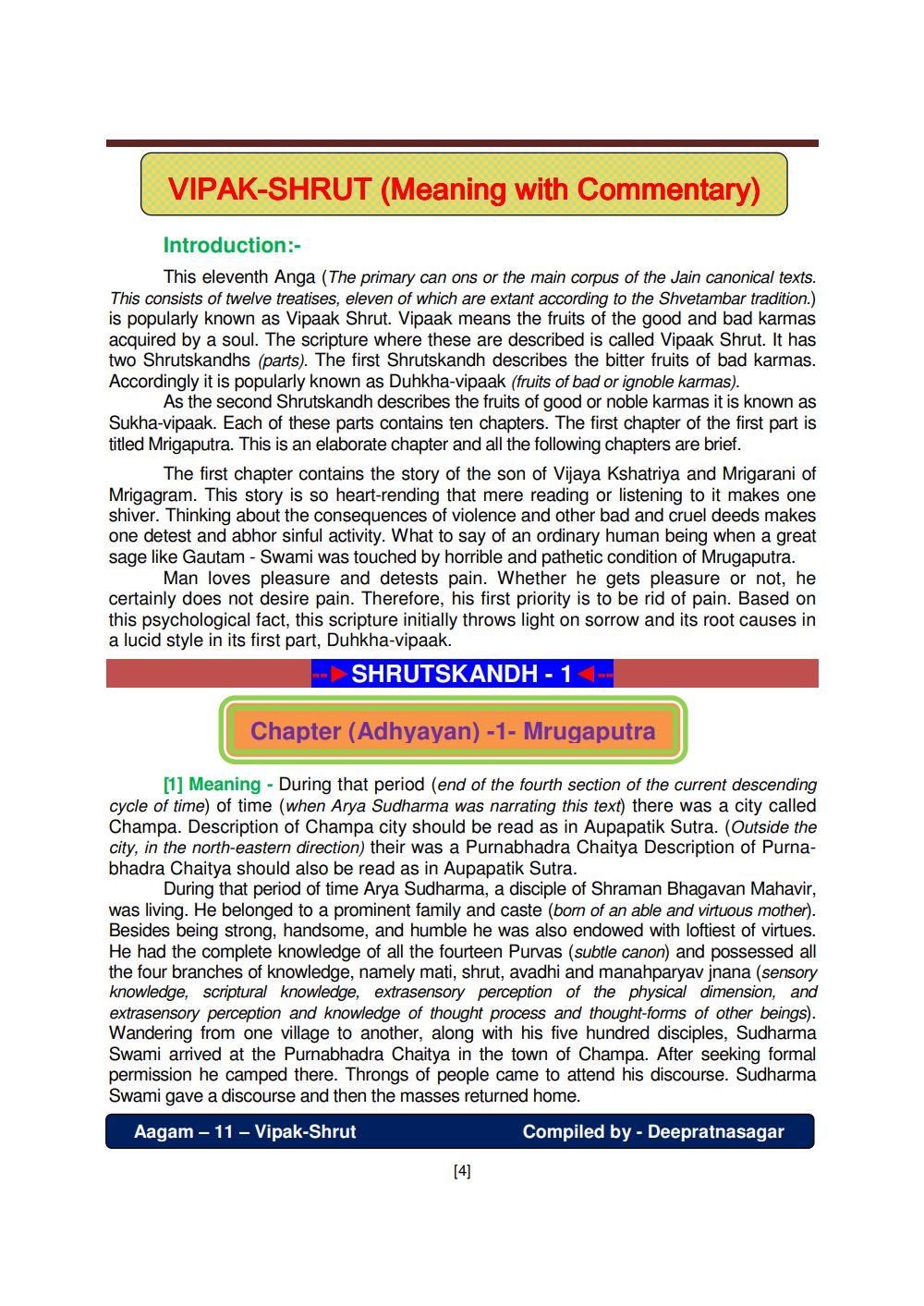Book Title: Agam 11 Ang 11 Vipak Sutra English Translation Author(s): Dipratnasagar, Deepratnasagar Publisher: Deepratnasagar View full book textPage 5
________________ VIPAK-SHRUT (Meaning with Commentary) Introduction: This eleventh Anga (The primary can ons or the main corpus of the Jain canonical texts. This consists of twelve treatises, eleven of which are extant according to the Shvetambar tradition.) is popularly known as Vipaak Shrut. Vipaak means the fruits of the good and bad karmas acquired by a soul. The scripture where these are described is called Vipaak Shrut. It has two Shrutskandhs (parts). The first Shrutskandh describes the bitter fruits of bad karmas. Accordingly it is popularly known as Duhkha-vipaak (fruits of bad or ignoble karmas). As the second Shrutskandh describes the fruits of good or noble karmas it is known as Sukha-vipaak. Each of these parts contains ten chapters. The first chapter of the first part is titled Mrigaputra. This is an elaborate chapter and all the following chapters are brief. The first chapter contains the story of the son of Vijaya Kshatriya and Mrigarani of Mrigagram. This story is so heart-rending that mere reading or listening to it makes one shiver. Thinking about the consequences of violence and other bad and cruel deeds makes one detest and abhor sinful activity. What to say of an ordinary human being when a great sage like Gautam - Swami was touched by horrible and pathetic condition of Mrugaputra. Man loves pleasure and detests pain. Whether he gets pleasure or not, he certainly does not desire pain. Therefore, his first priority is to be rid of pain. Based on this psychological fact, this scripture initially throws light on sorrow and its root causes in a lucid style in its first part, Duhkha-vipaak. - SHRUTSKANDH-1 Chapter (Adhyayan) -1- Mrugaputra [1] Meaning - During that period (end of the fourth section of the current descending cycle of time) of time (when Arya Sudharma was narrating this text) there was a city called Champa. Description of Champa city should be read as in Aupapatik Sutra. (Outside the city, in the north-eastern direction) their was a Purnabhadra Chaitya Description of Purnabhadra Chaitya should also be read as in Aupapatik Sutra. During that period of time Arya Sudharma, a disciple of Shraman Bhagavan Mahavir, was living. He belonged to a prominent family and caste (born of an able and virtuous mother). Besides being strong, handsome, and humble he was also endowed with loftiest of virtues. He had the complete knowledge of all the fourteen Purvas (subtle canon) and possessed all the four branches of knowledge, namely mati, shrut, avadhi and manahparyav jnana (sensory knowledge, scriptural knowledge, extrasensory perception of the physical dimension, and extrasensory perception and knowledge of thought process and thought-forms of other beings). Wandering from one village to another, along with his five hundred disciples, Sudharma Swami arrived at the Purnabhadra Chaitya in the town of Champa. After seeking formal permission he camped there. Throngs of people came to attend his discourse. Sudharma Swami gave a discourse and then the masses returned home. Aagam - 11 - Vipak-Shrut Compiled by - DeepratnasagarPage Navigation
1 ... 3 4 5 6 7 8 9 10 11 12 13 14 15 16 17 18 19 20 21 22 23 24 25 26 27 28 29 30 31 32 33 34 35 36 37 38 39 40 41 42 43 44 45 46 47 48 49 50 51 52 ... 71
